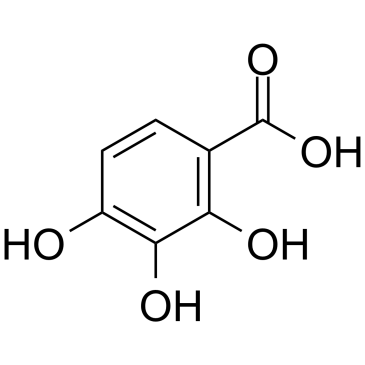2,3,4-Trihydroxybenzoic acid

2,3,4-Trihydroxybenzoic acid structure
|
Common Name | 2,3,4-Trihydroxybenzoic acid | ||
|---|---|---|---|---|
| CAS Number | 610-02-6 | Molecular Weight | 170.120 | |
| Density | 1.7±0.1 g/cm3 | Boiling Point | 437.5±45.0 °C at 760 mmHg | |
| Molecular Formula | C7H6O5 | Melting Point | ~205 °C (dec.)(lit.) | |
| MSDS | Chinese USA | Flash Point | 232.5±25.2 °C | |
| Symbol |

GHS07 |
Signal Word | Warning | |
|
Structure-Activity Relationships of Antimicrobial Gallic Acid Derivatives from Pomegranate and Acacia Fruit Extracts against Potato Bacterial Wilt Pathogen.
Chem. Biodivers. 12 , 955-62, (2015) Bacterial wilts of potato, tomato, pepper, and or eggplant caused by Ralstonia solanacearum are among the most serious plant diseases worldwide. In this study, the issue of developing bactericidal agents from natural sources against R. solanacearum derived fr... |
|
|
Development of a quantitative high-performance liquid chromatography-photodiode array detection measurement system for phenolic acids.
J. Chromatogr. A. 1038(1-2) , 97-105, (2004) A quantitative high-performance liquid chromatography-photodiode array detection method separating 16 phenolic acids was achieved. Six columns and several mobile phases were investigated. Resolution was achieved with a high-purity silica Phenomenex Luna C18 c... |
|
|
Catalytic spectrophotometric determination of vanadium in seawaters based on the bromate oxidative coupling reaction of metol and 2,3,4-trihydroxybenzoic acid.
Anal. Sci. 17(6) , 769-73, (2001) A new, simple, sensitive and selective catalytic method is developed for the determination of vanadium in natural and sea waters. The method is based on the catalytic effect of V(V) and/or V(IV) on the bromate oxidative-coupling reaction of metol with 2,3,4-t... |
|
|
Oxidative dimer produced from a 2,3,4-trihydroxybenzoic ester.
Biosci. Biotechnol. Biochem. 71(7) , 1731-4, (2007) The DPPH radical-scavenging abilities of the naturally occurring phenolic acid, 2,3,4-trihydroxybenzoic acid, and its methyl ester were evaluated. Both compounds in acetonitrile scavenged as many as four radicals compared to three or fewer radical consumption... |
|
|
The effects of gallic acid on pain and memory following transient global ischemia/reperfusion in Wistar rats.
Avicenna J Phytomed 3 , 329-40, (2014) It is generally agreed that most of the phenomena observed during brain ischemia and reperfusion can be explained by the damage to membrane structure. Oxidative stress is resulted in an imbalance between high consumption of oxygen and low levels of endogenous... |